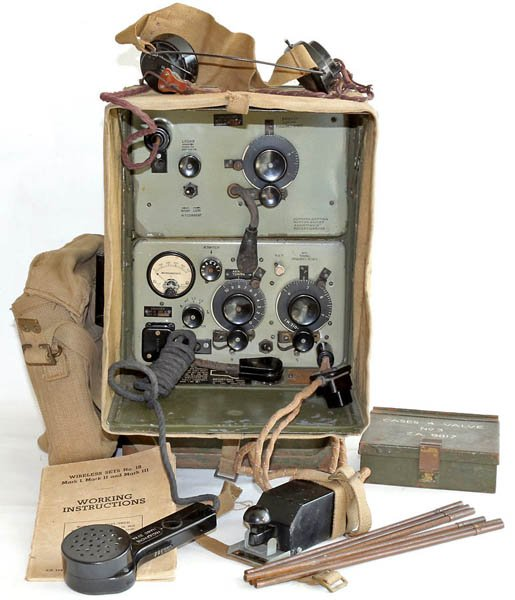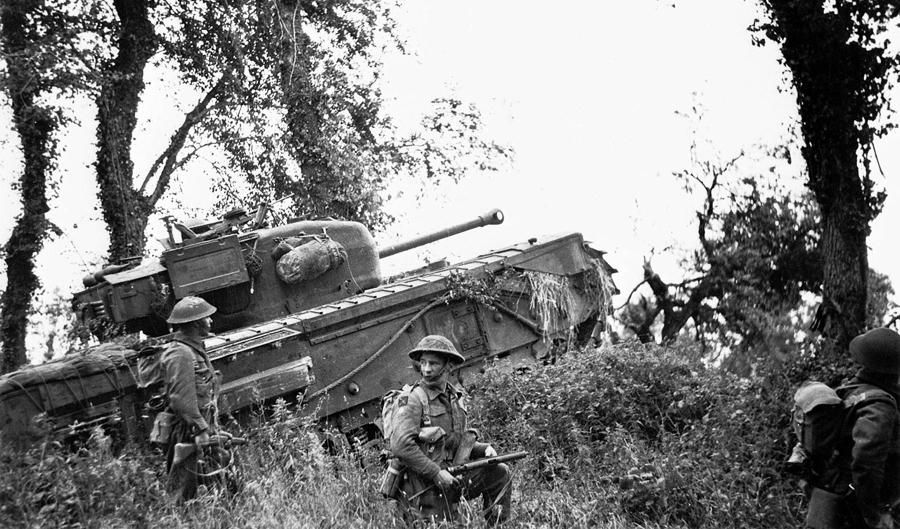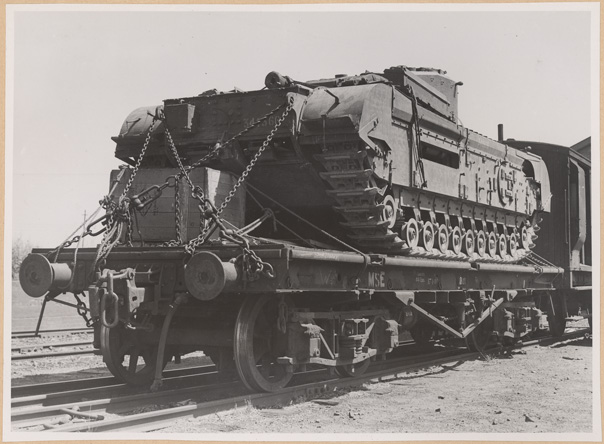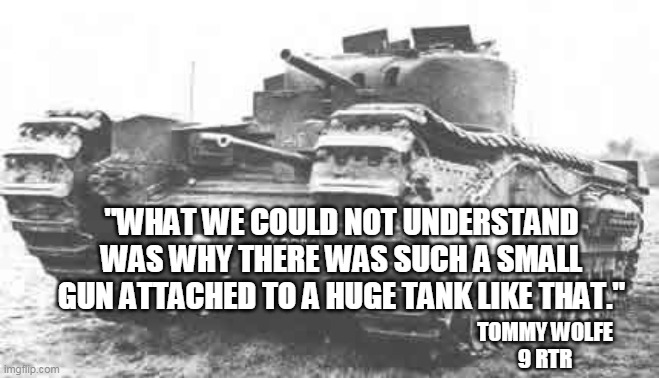
So you're a company commander in Normandy, trying to coordinate your three platoons in action, & liase w supporting tanks & some arty, & keep battalion headquarters appraised, & adapt as needed.
You know your platoons' sets are a bit crap.
What do you do? /1
#WW2 #SWW #History
You know your platoons' sets are a bit crap.
What do you do? /1
#WW2 #SWW #History

The whole thing is a bit of a juggling act.
The core set at Company HQ was the WS No. 18 set, linking in with WS No. 38 sets used by platoons & back to Battalion HQ.
0.25 Watts
6-9Mhz
2.5 miles range with R/T and 4 miles with W/T
Interference in woodlands/around armour /2
The core set at Company HQ was the WS No. 18 set, linking in with WS No. 38 sets used by platoons & back to Battalion HQ.
0.25 Watts
6-9Mhz
2.5 miles range with R/T and 4 miles with W/T
Interference in woodlands/around armour /2

The 18 set was more durable than the WS No. 38, but much less powerful than the popular WS No. 19 and 22 sets... then again you can carry it about and not worry about a vehicle or cart for it in action. /3 

Much like the WS No. 38 set, the No. 18 set also relies on a rather conspicuous aerial - 10' (3m) high.
The Army knew such height wasn't desirable and trials of ground trailing aerials for the 18 and 38 sets were underway in theatre but there were problems... /4
The Army knew such height wasn't desirable and trials of ground trailing aerials for the 18 and 38 sets were underway in theatre but there were problems... /4

It performed poorly on wet ground, and Normandy was... frequently soggy, whilst movement through thick undergrowth could damage the copper wire which also had the habit of snapping if stepped on.
So signallers, and those around them, had to be pretty considerate in action. /5
So signallers, and those around them, had to be pretty considerate in action. /5

Given the opportunity cost of having a giant target clearly denoting Company HQs or using rather finicky ground aerials, the latter did show promise.
So operational trials in Normandy were pushed - with 4 Welch becoming frequent users by 2 August. /6
So operational trials in Normandy were pushed - with 4 Welch becoming frequent users by 2 August. /6

No. 18 sets were much larger backpack mounted radios held on with heavy duty soldier straps and a modified 08 pattern belt.
Once frequencies were set the waterproof canvas cover could be sealed over the core controls.
Receiver - top
Sender - bottom /7
Once frequencies were set the waterproof canvas cover could be sealed over the core controls.
Receiver - top
Sender - bottom /7

Despite being of better construction than the WS No. 38, it was still not thought highly of by XII Corps.
It's best viewed as what it is, a man-portable compromise. /8
It's best viewed as what it is, a man-portable compromise. /8

A core problem was that... well... 19 and 22 sets could easily 'swamp' No. 18 sets in action.
As could tanks (big metal boxes), woodland, terrain, and... umm... other, more powerful radios.
Umm...
Such chonky wireless sets were pretty common. /9
As could tanks (big metal boxes), woodland, terrain, and... umm... other, more powerful radios.
Umm...
Such chonky wireless sets were pretty common. /9

Like, every tank has a WS No. 19 set in it, which are fantastic pieces of kit.
Tanks are also big metal interference boxes.
Forward Observation Officers (FOOs) often have 18 and 19 sets.
Battalion HQ has a 22 set, with Tac HQ using 18 sets... airwaves can get cluttered. /10
Tanks are also big metal interference boxes.
Forward Observation Officers (FOOs) often have 18 and 19 sets.
Battalion HQ has a 22 set, with Tac HQ using 18 sets... airwaves can get cluttered. /10

*Insert a strange note that Churchill appears to cause more interference than Sherman but that's another story for another day when we look at tank/inf comms in detail which is an amazing story you will all totally enjoy involving balls of steel and the occasional hammer* /11 

Even when the wireless net is carefully managed by the Royal Signals it can get pretty messy very quickly.
And... umm... frequencies can easily repeat just an independent brigade or division over, risking ample confusion.
Eavesdropping was common by both sides.* /12
And... umm... frequencies can easily repeat just an independent brigade or division over, risking ample confusion.
Eavesdropping was common by both sides.* /12

*It remained common for other battalions to listen in to actions & keep track of events - occasionally taking notes and shoving these scraps of paper in war diaries...
This means, occasionally, one finds good detailed records of a rather distant engagement!* /13
This means, occasionally, one finds good detailed records of a rather distant engagement!* /13

Now bare in mind that each of your platoons' WS No. 38 sets probably has half a mile range if using 4' battle aerials, common sensible practice, & these are underpowered.
You've just got so much interference about you need damn good signallers.
Who are in short supply. /14
You've just got so much interference about you need damn good signallers.
Who are in short supply. /14

It is very hard to replace such skilled personnel in the event of casualties, and the rate of attrition is such that they will become casualties - it is really just a matter of when.
Investigations of the causes of interference were not always helpful... /15
Investigations of the causes of interference were not always helpful... /15

Units would rotate in and out of an area, and the same problems would persist - which divisional signals etc would normally blame on atmospheric conditions such as fog, rather than the terrain/woods/valleys/ground - which was really the bigger problem. /16 

It doesn't help the reports on which they relied on could frequently be incomplete datasets and flat out contradictory.
Not least as the key knowledgeable personnel were high priority targets carrying big aerials indicating where they were & likely to fall as casualties. /17
Not least as the key knowledgeable personnel were high priority targets carrying big aerials indicating where they were & likely to fall as casualties. /17

So if your company wireless net fails, what then?
Runners & messengers remained popular but were vulnerable to enemy fire, similarly some officers would pop onto the RA or tankie nets to communicate back.
Systems were relatively slick in allowing information to flow. /18
Runners & messengers remained popular but were vulnerable to enemy fire, similarly some officers would pop onto the RA or tankie nets to communicate back.
Systems were relatively slick in allowing information to flow. /18

Some companies went to near-comic extremes to guarantee communications, lugging forward captured telephone exchanges, field telephones and spools of cable reel.
This could leave fields and villages strung with random cable like a yeeting kid with silly string. /19
This could leave fields and villages strung with random cable like a yeeting kid with silly string. /19

Numerous actions that should have never happened probably owe themselves to 18 set failures, such as Tasker Watkin's scrap where he earned his VC near Martigny.
1/5th Welch Bn HQ ordered B Coy to not cross the road, for fear of stirring hornets' nest. But this never arrived. /20
1/5th Welch Bn HQ ordered B Coy to not cross the road, for fear of stirring hornets' nest. But this never arrived. /20

When analysing engagements in Normandy this trend becomes all to clear, but was obfuscated by the very tiny no. of accounts.
I mean small.
Infantry combat is extremely violent.
Of a battalion of approx 800 men you can find a handful of accounts, occasionally as low as 0.4% /21
I mean small.
Infantry combat is extremely violent.
Of a battalion of approx 800 men you can find a handful of accounts, occasionally as low as 0.4% /21

As a result we deal with very weak datasets, which takes a lot of work to analyse, deconstruct & reconstruct narrative from.
It's why we have so much poor, quickly researched feedback looped history repeatedly pumped out on the same subjects. /22
It's why we have so much poor, quickly researched feedback looped history repeatedly pumped out on the same subjects. /22

So any glimpse at the No. 18 set is complicated, esp as comms failure could easily bring all those involved a cropper.
That company attacks by British and Commonwealth infantry succeeded when relying on such temperamental essential kit... /23
That company attacks by British and Commonwealth infantry succeeded when relying on such temperamental essential kit... /23

speaks volumes as to the infantry's ability to quickly adapt, know their job, improvise on the fly, clearly communicate and excel in exceptionally adverse situations.
Perennially pertinent. /thread
Perennially pertinent. /thread

*Some of the above images are pre-Normandy, with a smattering from Italy.
Hope it doesn't detract.
Hope it doesn't detract.
• • •
Missing some Tweet in this thread? You can try to
force a refresh






















